-
Posts
3,555 -
Joined
-
Last visited
-
Days Won
22
Content Type
Profiles
Forums
Blogs
Gallery
Downloads
Media Demo
Events
Everything posted by GeeBee
-

Cannot Fly 5 Hours With Manual Throttle?
GeeBee replied to GeeBee's topic in Miscellaneous Aviation Talk
That is basically how they would have to operate this airplane without a TAT probe. -

Cannot Fly 5 Hours With Manual Throttle?
GeeBee replied to GeeBee's topic in Miscellaneous Aviation Talk
They had started their duty day in SFO after a proper rest period. They had plenty of rest (if they used the rest opportunity) and they both signed the dispatch release document which states their physical state including medical and rest was/is adequate. That is why the Duty pilot in dispatch was saying they really don't want to return saying they were not rested because they have indicted themselves with an admissions against their own interest. -

Cannot Fly 5 Hours With Manual Throttle?
GeeBee replied to GeeBee's topic in Miscellaneous Aviation Talk
No engine anti-ice also protects the lip and inlet duct so ice does not come crashing off into the fan blades. The fan blades themselves are anti-iced by engine rpm.. A "no-ice dispatch" concerns itself only with forecast icing conditions which is visible moisture and temperatures near zero. -

Cannot Fly 5 Hours With Manual Throttle?
GeeBee replied to GeeBee's topic in Miscellaneous Aviation Talk
Yes, the failure of the TAT probe caused the A/T disconnect (because the A/T computer can no longer calculate engine limits) however, the only requirement in the case of TAT failure is to avoid icing conditions. If you listen the dispatcher amends his release to "no ice" and tells the crew they are good to go "no ice". based upon forecast conditions along the route. Flown that kind of release a thousand times. Not a big deal. As to engine limits, all that is needed is to refer to manual and manually set the EPR bugs to reflect the limits. -

Cannot Fly 5 Hours With Manual Throttle?
GeeBee replied to GeeBee's topic in Miscellaneous Aviation Talk
I remember before RVSM flying a 5 leg day in a 737 with no A/P and no A/T. These guys are girly-men. -

Encore TKS FIKI performance in moderate icing?
GeeBee replied to Beestforwardspeed's topic in Modern Mooney Discussion
I have flown my Ovation several times in moderate ice. It works really good, but make sure you know your system is working 100% before you challenge it. As mentioned, turn it on well in advance, at least 10 preferably 15 minutes. Get your airplane "soaped up" and you will be impressed. That all said, don't go looking for it, but use it as an option. I always leave myself an "out", like knowing I can descend or turn around. Don't box yourself into a corner with TKS being your only out. -
Don't do it! You may become fatigued!
-
Personally, if I was looking down the barrel of a Lycoming overhaul, I would be talking to Carlus Gann at Gann Aviation. Much better engine in maybe faster time.
-
There was a young man who was hired by his uncle as employment of last resort. He was a toothbrush salesman. His performance was so poor, his uncle said he had one month to improve or be fired. The next month he sold more toothbrushes than anyone, and for an average of $130 per brush. HIs uncle was so pleased, he asked what did he do to render such an unbelievable performance. He said; "I set up a table at the airport with a bowl of chips and a bowl of chips. As pilots went by I asked them if they wanted to try the chips and dip. When they did they said the dip tasted like dog doo-doo. I said, it is dog doo-doo, wanna buy a toothbrush?"
-
Hydration is so important and realistically you need to pee at least every 4 hours. So you should have something to pee into if you are going over 4 hours. When I was flying the line on transoceanic trips, I cut my inflight medical emergencies down to nothing by getting the flight attendants to offer water and lots of it every hour. Once I started with that, it was amazing the difference in passenger well being by proper hydration. Proper hydration means of course you have to pee and a healthy human can't go more that 3-4 hours without urinating. Second to this is oxygen saturation. Yeah you can fly at 10K, but 10K for four hours without oxygen boost is really hard on the body as constant low level hypoxia takes a toll on you well being and alertness. Even in pressurized aircraft, if the cabin was at 8K I would take a few minutes on O2 often before top of descent. I makes a real difference! Proper hydration and watching your oxygen saturation makes for a much better and safer flight.
-
Well Lycoming produces 3000 engines per year of all sizes, P&W produces 1000 PT6A engines per year.
-
No, you are taking me out of context. My claim was material and and I said, "In addition, the casting and forging have to be several higher orders of precision." Again, when you look at the forging of that disk on a CF6 vs forging a crankshaft, they are worlds apart in materials, material casting, forging methods and precision. The average crankshaft probably has 6 inclusions that caused that CF6 disk to come apart.
-
I spent 40 years in the industry. I retired off the A330 and I loved every minute of it. To make it worthwhile it must be something you want to do and not think of it as a job. I never worked a day in my life. 6 years after retirement I still have dreams in my sleep of flying transport airplanes. If you are not sure, it is going to be a job. If you are sure (and I was from 5 years old) it is a living dream. I survived 5 years of furlough, 1 near bankruptcy, 1 real bankruptcy, 3 mergers. I have two uniforms in my closet and I would not change a thing. Pay? Who cares when you love your job, but my retirement placed me in the top 3% of Americans. Can't beat that. Let me add, my first wife had pancreatic cancer and thanks to my airline who put out over 2 million for her she never wanted for a thing. No insurance arguments, no "if only's" they just wrote the checks. My first Christmas with my second wife I spent in Accra, Ghana. Not where I wanted to be, but you have to take the good with the bad, because the bad, ain't that bad.
- 17 replies
-
- 14
-

-
I am missing your math. You say an IO-360 weighs 300 pounds (136kg) and a PT6A is 500 pounds (226kg). Then you say aluminum is $2.50/kg and Inconel 600 is $45/kg. So in your raw terms the material costs of an IO-360 is $340 (136x2.50) and a PT6A is $10,000 (226x45). So the material costs of a PT6A is 29 times an IO-360. So compared to a new IO-360 at 100K a new PT6 at 29X is 2.9 million. We know that it is about 1 million new so the PT6A is quite a value based upon your math.
-
Materials. Think how much an IO-360 would cost if the entire engine were constructed of exhaust valve material instead of simple cast aluminum and steel. In addition, the casting and forging have to be several higher orders of precision. You can cast a cylinder head fairly rough and machine it down substantially into a usable part. Not so with a compressor blade. If you remember the compressor disk off UAL 232 you get an idea of the level of purity, quality of material and manufacturing required.
-

Anxious and Empathetic - Hurricane Milton
GeeBee replied to mmcdaniel33's topic in Modern Mooney Discussion
You all can count the pennies to run it. The ROI over the years. Calculate your need. No mathematics will account for one intangible. Your wife. Do you really want to sleep in your own bed, or the couch? Did I tell you I am a very happily married man? -
You won't need them until you fly in the clouds, get a nice big corona around your airplane and go NORDO.
-
Even P&W highly recommends engine trend monitoring and even offers the own including automatic data acquisition. Hard TBOs are yesterday's news for turbine operators who want the most out of their engines. https://www.prattwhitney.com/en/blogs/airtime/2018/12/11/why-engine-condition-trend-monitoring-is-a-must-for-pt6as
-
Most part 135 PT-6 engines are trend monitored very few Ops Specs are written for PT-6s with hard times vs trend monitoring. (Most the time because the airplane was added to the fleet used without trend monitoring) Trend monitoring dates all the way back to the 1980s (because of the PC) and I know this because I ran a fleet of 3 King Airs under Part 135 in the 1980s all on trend monitoring. On average you can get about 2400 hours before hot section and 4800 to overhaul on a trend monitored engine. Anything more is playing with fire, literally. If you acquire an engine that timed out on hard time spec under Part 135 you might get 600 hours out of it, but not much more and usually less as many have found out. They are great engines, but when hot section deterioration starts it happens fast and just gets more expensive putting it off. The problem with the acquisition of such an engine that was not trend monitored is you have no base line to know when things start going south....until they do.
-
I am not sure if it was the one over at KCVC. Visually not too bad.
-
The C-210 conversion uses an installed fuselage tank to make the turbine work. It makes it a 4 place airplane. Otherwise it is an airplane in search of a fuel stop.
-
Turbine conversions usually end up range/payload limited.
-

Anxious and Empathetic - Hurricane Milton
GeeBee replied to mmcdaniel33's topic in Modern Mooney Discussion
On average you will run about 30% power if you run 24/7. Buy your propane tank and own it. Then you are free to buy from whatever supplier you want. This creates a higher level of security from a supply standpoint. -

Anxious and Empathetic - Hurricane Milton
GeeBee replied to mmcdaniel33's topic in Modern Mooney Discussion
Oh yes. I have an all electric house with a 400 amp service. I have a 500 gallon propane tank. Typically it burns on average about 3.2 gallons propane per hour (average 30% power) which gives me a little over 5 days. If I decide to ration it, by not running at night for instance I could easily make 10-12 days. If I really rationed it, I am sure I could make a month. I calculate my rationing by the availability of propane. Last year for instance I could have a propane truck in my driveway in hours, so no need to ration. I have a monthly keep full on the tank. The engine is a 4 cylinder Mitsubishi turbo charged. https://www.generac.com/globalassets/products/residential/standby-generators/spec-sheets/xg03245-xg04045_hsb_specsheet.pdf -

Anxious and Empathetic - Hurricane Milton
GeeBee replied to mmcdaniel33's topic in Modern Mooney Discussion
Weather is always shifting. As to generators, I have a 40KW whole house. Last year had a huge line of T-storms with a massive down burst right over my house. Living out on a peninsula we are always the last to get re-wired. Ran 5 days 24/7 with 6 grandkids in the house. Ops completely normal other than all the downed trees. Get a whole house, you'll never regret it.


